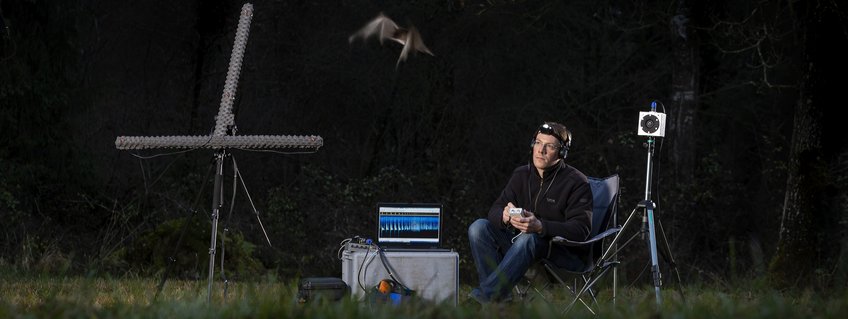Acoustic and Functional Ecology
The Emmy Noether funded research group “Acoustic and Functional Ecology” investigates the functional and ecological principles of sensory processing and associated animal behaviour. We pursue these questions in the ecologically important context of predator-prey interactions, using echolocating bats and eared insects as model systems of auditory information processing and auditory-guided behaviour.
Sensory processes are at the centre of an animal’s perception of the world and its actions in this world, including some of the most crucial behaviours for survival such as foraging and predator avoidance. Accordingly, natural selection has not only shaped the morphology of animals, but also their sensory and behavioural properties. Our overall scientific objective is to understand the function of sensory systems and their consequences for ecological and evolutionary processes. In our research, we study bats and moths as two model systems for complex and simple auditory processing and auditory-guided behaviour.
Echolocating bats rely to a large extent on auditory information for orientation, foraging and communication. Bats are thus a great model system to study auditory processing and the adaptation of sensory processes to ecological requirements. In our research, we address questions of sound-based perception of the environment, the use of sound for inter-individual and inter-specific interactions, the importance of dynamic sensory processing for the perception of complex and variable auditory scenes, and effects of the environment, including climate change, on sound-based perception.
In contrast to the flexible sensory-motor system of bats, the ears of noctuoid moths are simple. They consist of only 1-4 auditory neurons and trigger a two-staged evasive flight response, consisting of directional and erratic flight to escape attacking bats. The well-studied neurobiology of the simple moth ear provides an ideal foundation for a systematic study of the evasive behaviour of moths, which is the phenotype selected by bat predation. Moth families differ in the number of auditory receptor cells (1-4 cells) and additional antipredator strategies. This allows to study the function and adaptive value of evasive flight and protean escape mechanisms in a comparative approach and to test biological hypotheses, for example on the risk-dependent evolution of erratic flight, sustained erratic flight without sensory input and phenotypic variability as adaptation to predation pressure.
Echolocating bats and moths with bat-detecting ears are tightly connected in an evolutionary arms race. Their predator-prey-relationship is solely based on acoustic information and auditory-guided behaviour for foraging and for predator avoidance, respectively. They interact with one another in a functional, ecological and evolutionary relationship, adding additional layers of complexity and interdependence. Our research addresses auditory processing and auditory guided behaviours on all these levels, from individuals to populations. They are thus a perfect and highly integrated model system to study auditory-guided flight at two extremes of sensory processing.
Highlights of the Max Planck Yearbook 2018
Just published: Our research in the Research Highlights of the Yearbook 2018. Holger Goerlitz’s report about predator-prey-interactions for the Max Planck Yearbook 2018 was chosen as one of the 15 Highlights of the Max Planck Society 2018.
Bats can echolocate even in dense swarms
In our new modelling study in PNAS, we show that actively echolocating bats can still hear returning echoes, despite all the loud masking calls of their neighbours. The presumed cocktail party nightmare is thus rather a challenge than a nightmare. Bats detect echoes of their closest and frontal neighbours.
This spatial limitation might even be beneficial for following their neighbours during emergence.
Light pollution makes moths easy prey for bats
Artificial light at night interferes with the sound-triggered evasive flight of moths. Our new study in Ecology & Evolution suggests, that human light pollution suppresses both types of evasive flight, making moths more vulnerable to bats than assumed before.
Perceptual mechanisms of noise pollution
Although anthropogenic noise is a widespread pollutant, we have a limited understanding of the perceptual mechanisms of noise disturbance. Noise is affecting bats via multiple perceptual mechanisms (masking and distraction), and bats show individual differences in their ability to cope with noise.
Task-dependent vocal adjustments to optimize information acquisition
Having the right information for a specific job is crucial. Echolocating bats flexibly and independently adjust different call parameters to match the sensory-motor challenges of four different tasks.
„Acoustic tunnel vision“ to hunt succesfully
Novel echo- and motion data reveal for the first time the primary sensory flow of free-flying hunting bats. The bats adjust both echolocation and orientation to focus on their prey and reduce interfering echoes – actively creating a kind of “acoustic tunnel vision” to simplify their auditory scene.
Acoustic monitoring of bats at wind turbines is severely limited.
Wind turbines kill many animals. To mitigate this green-green-dilemma, bat activity near wind turbines is monitored by acoustic detectors.
However, the limited range of acoustic detection means that bats are only detected within a very small part of the overall risk area. More detectors and additional methods are needed to avoid biodiversity loss by green energy production.
Wind energy and bat fatalities
How improving acoustic monitoring of bats at wind turbines could help protecting biodiversity. Animation video summarizing our recent paper (Voigt et al 2021 Mammal Review).
Balancing the costs
Echo- and motion biologging tags reveal how wild bats balance the costs for sound production with the flow rate of sensory information. Bats prioritize energy efficiency over sensory flow during navigation and prey search, but maximize sensory flow at increased energetic costs during prey attack. Overall, the energetic are low due to the biomechanical coupling of vocalisations to wing beat and the limited use of high sensory flow rates.









